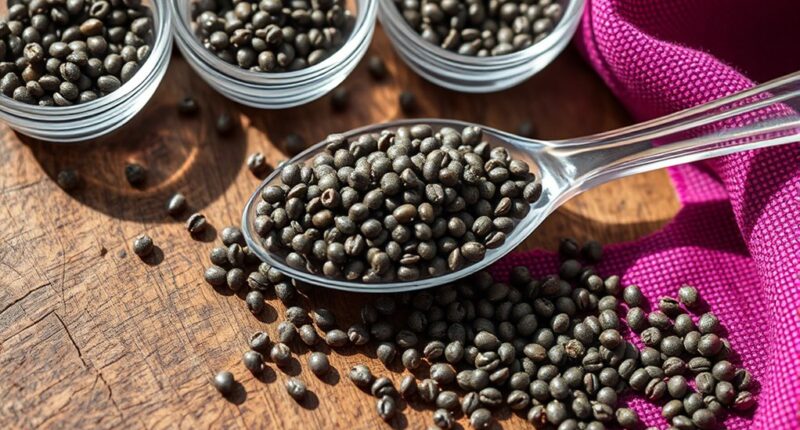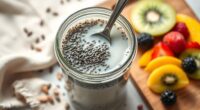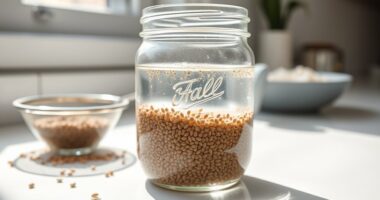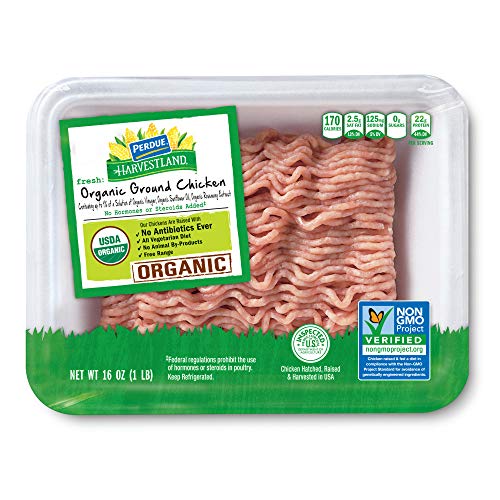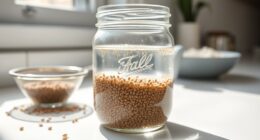To understand chia seed serving sizes, stick to about 1 to 2 tablespoons per day. This amount provides essential nutrients like fiber, omega-3s, and minerals without causing digestive issues or extra calories. Starting small helps your body adapt, and gradually increasing ensures sustainability. Proper portioning maximizes health benefits while preventing discomfort. For tips on storage and more details, continue exploring how to incorporate chia seeds effectively into your diet.
Key Takeaways
- A typical serving size of chia seeds is about 1 to 2 tablespoons.
- One tablespoon of chia seeds contains approximately 60 calories.
- Small servings help maximize nutrients while minimizing digestive discomfort.
- Starting with 1 tablespoon and gradually increasing is recommended.
- Proper portioning supports health benefits without overconsumption.

Chia seeds are small but powerful nutritional boosters, and understanding proper serving sizes is key to maximizing their health benefits. When you get the hang of how much to eat, you’ll be able to enjoy their full nutritional potential without overdoing it. A typical serving size of chia seeds is about one to two tablespoons, which provides a good balance of nutrients without causing digestive discomfort or excess calorie intake. This small amount packs a punch, offering fiber, omega-3 fatty acids, protein, and essential minerals like calcium and magnesium. Consuming the right portion ensures you experience their nutritional benefits fully, whether you’re adding them to smoothies, yogurt, or oatmeal. Knowing proper serving sizes also helps you manage your overall calorie intake, especially if you’re watching your weight. Since chia seeds are calorie-dense—roughly 60 calories per tablespoon—you don’t need a large amount to gain their health benefits. Eating too much at once, however, can lead to bloating or digestive issues because of their high fiber content. It’s best to start with small servings and gradually increase as your body adjusts. This way, you can enjoy their nutritional benefits without discomfort, and it helps you develop a sustainable habit. Additionally, understanding the fiber content of chia seeds can help you better appreciate their role in promoting satiety and weight management. Storage tips are just as important as knowing your serving size. To maintain their freshness and nutritional quality, store chia seeds in an airtight container in a cool, dark place, such as a pantry or cupboard. Proper storage prevents exposure to light, air, and moisture, which can degrade their nutrients over time. If you buy in bulk, transferring chia seeds into smaller containers makes it easier to access a portion while keeping the rest sealed tightly. For longer shelf life, you can also refrigerate or freeze chia seeds, especially if you don’t plan to use them frequently. Just ensure they’re stored in a moisture-proof container to prevent clumping or spoilage.
Frequently Asked Questions
Can Chia Seeds Be Eaten Raw or Should They Be Cooked?
You can eat chia seeds raw or soaked, and there’s no need to cook them. Just store your chia seeds in a cool, dry place to keep them fresh and prevent spoilage. If you have chia seed allergies, avoid consuming them, whether raw or cooked. Soaking or adding chia seeds to recipes enhances their texture and nutrient absorption, making them a versatile ingredient for your diet.
How Does Soaking Chia Seeds Affect Their Nutritional Value?
When you soak chia seeds, their nutrient absorption improves because the process activates enzymes that break down their outer shell. Soaking also makes it easier for your body to access essential nutrients like omega-3s, fiber, and protein. Plus, it reduces the risk of digestive discomfort. So, by soaking, you’re enhancing enzyme activation and ensuring you get the most nutritional benefit from each seed.
Are There Any Health Risks With Eating Too Many Chia Seeds?
Like a double-edged sword, eating too many chia seeds can pose health risks. You might experience gastrointestinal discomfort, such as bloating or constipation. There’s also a chance of potential allergenic reactions, especially if you’re sensitive. Moderation is key—stick to recommended serving sizes to enjoy chia seeds’ benefits without risking adverse effects. Listening to your body helps prevent any unwanted side effects from overindulgence.
How Do Chia Seed Servings Vary for Different Age Groups?
You should adjust chia seed servings based on age-specific nutrition needs and portion control guidelines. For children, smaller portions like 1 teaspoon to 1 tablespoon are recommended, while adults can typically enjoy 1 to 2 tablespoons daily. Teenagers may fall somewhere in between. Always consider individual health and consult a healthcare professional for personalized advice, ensuring you get the benefits without overdoing it.
Can Chia Seeds Replace Other Dietary Fiber Sources Effectively?
Like a trusted confidant, chia seeds can effectively replace other dietary fiber sources. They offer a rich fiber comparison, helping you meet your daily goals. You can incorporate chia seeds into smoothies, yogurt, or oatmeal, making them a versatile dietary replacement. While they are a powerful fiber source, it’s best to combine them with other fiber-rich foods for ideal digestive health and balanced nutrition.
Conclusion
Now that you know the proper serving sizes, you can enjoy chia seeds without overdoing it. Think of them as tiny nutritional powerhouses—small in size but big in benefits—yet too much can be counterproductive. Just like a spoonful of sugar sweetens your tea, the right portion boosts your health without overwhelm. So, remember: moderation is key. Use these little seeds wisely, and they’ll be your big ally in a healthier lifestyle.
